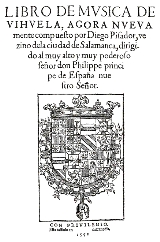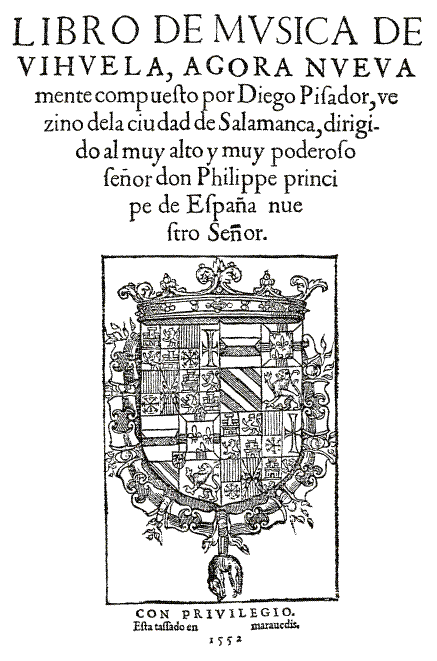
Diego Pisador
Encyclopedia
Diego Pisador was a Spanish
vihuelist
and composer of the Renaissance
.
around the years 1509 or 10. He was the oldest son of Alonso Pisador and Isabel Ortiz, who married in 1508. Ortiz's father, Alfonso III of Fonseca, Archbishop of Santiago, was a great patron of music. Alonso Pisador worked as a notary in the audience of the archbishop and, in 1524, he moved to Toledo
, following his steps. There he entered the service of the count of Monterrey
, possibly Alonso de Acevedo y Zúñiga, who was also a grandson of Alfonso III. In 1526 Pisador took minor orders
, but did not continue in an ecclesiastical career.
In 1532, his father moved to Galicia following Alonso de Acevedo y Zúñiga as the corregidor
of Monterrey. He would not return to Salamanca until 1551, after his wife died in September of 1550. He settled in Salamanca in the care of his mother and his younger brother. He had charge of the economic affairs of the family and the position of majordomo/administrator in the city of Salamanca, once held by his father.
At the death of his mother, Diego inherited the lion's share of the family fortune, which upset his younger brother. Initially, the father sided with Diego in this dispute, but he threatened to marry and abandon his work on the book of vihuela
music which had occupied him up to then. When the father returned to Salamanca a short time later, he had a change of opinion, supported the other brother, and forced Diego to leave the family home. It is known that in 1553, Diego sold the house and that in 1557 father and son were still at odds.
 In 1552, he published a book of works for vihuela titled Libro de música de vihuela, dedicated to Philip II of Spain
In 1552, he published a book of works for vihuela titled Libro de música de vihuela, dedicated to Philip II of Spain
. It is divided into 7 books and consists of 95 pieces, although if one considers, as Pisador did, each one of the parts of the compositions as a separate work, the book contains a total of 186 pieces. Pisador worked on the book for six years. 58 of the 95 are for voice and vihuela, and 37 are for vihuela solo.
As was common at the time, many of the works are transcription
s (or intabulations) for vihuela of works by other composers such as Juan Vásquez
, Juan García de Basurto
, Mateo Flecha el viejo, Josquin des Prez
, Nicolas Gombert
, Adrian Willaert
, Jean Mouton
, Jacques Arcadelt
, V. Fontana and Costanzo Festa
.
Spain
Spain , officially the Kingdom of Spain languages]] under the European Charter for Regional or Minority Languages. In each of these, Spain's official name is as follows:;;;;;;), is a country and member state of the European Union located in southwestern Europe on the Iberian Peninsula...
vihuelist
Vihuela
Vihuela is a name given to two different guitar-like string instruments: one from 15th and 16th century Spain, usually with 12 paired strings, and the other, the Mexican vihuela, from 19th century Mexico with five strings and typically played in Mariachi bands.-History:The vihuela, as it was known...
and composer of the Renaissance
Renaissance music
Renaissance music is European music written during the Renaissance. Defining the beginning of the musical era is difficult, given that its defining characteristics were adopted only gradually; musicologists have placed its beginnings from as early as 1300 to as late as the 1470s.Literally meaning...
.
Life
Little is known of the details of Pisador's life, not even the exact dates of his birth and death. It is known that he was born in SalamancaSalamanca
Salamanca is a city in western Spain, in the community of Castile and León. Because it is known for its beautiful buildings and urban environment, the Old City was declared a UNESCO World Heritage Site in 1988. It is the most important university city in Spain and is known for its contributions to...
around the years 1509 or 10. He was the oldest son of Alonso Pisador and Isabel Ortiz, who married in 1508. Ortiz's father, Alfonso III of Fonseca, Archbishop of Santiago, was a great patron of music. Alonso Pisador worked as a notary in the audience of the archbishop and, in 1524, he moved to Toledo
Toledo, Spain
Toledo's Alcázar became renowned in the 19th and 20th centuries as a military academy. At the outbreak of the Spanish Civil War in 1936 its garrison was famously besieged by Republican forces.-Economy:...
, following his steps. There he entered the service of the count of Monterrey
Monterrey
Monterrey , is the capital city of the northeastern state of Nuevo León in the country of Mexico. The city is anchor to the third-largest metropolitan area in Mexico and is ranked as the ninth-largest city in the nation. Monterrey serves as a commercial center in the north of the country and is the...
, possibly Alonso de Acevedo y Zúñiga, who was also a grandson of Alfonso III. In 1526 Pisador took minor orders
Holy Orders
The term Holy Orders is used by many Christian churches to refer to ordination or to those individuals ordained for a special role or ministry....
, but did not continue in an ecclesiastical career.
In 1532, his father moved to Galicia following Alonso de Acevedo y Zúñiga as the corregidor
Corregidor (position)
A corregidor was a local, administrative and judicial position in Spain and its empire. He was the highest authority of a Corregimiento. In the Americas a corregidor was often called an alcalde mayor. They began to be appointed in fourteenth century Castile and the institution was definitively...
of Monterrey. He would not return to Salamanca until 1551, after his wife died in September of 1550. He settled in Salamanca in the care of his mother and his younger brother. He had charge of the economic affairs of the family and the position of majordomo/administrator in the city of Salamanca, once held by his father.
At the death of his mother, Diego inherited the lion's share of the family fortune, which upset his younger brother. Initially, the father sided with Diego in this dispute, but he threatened to marry and abandon his work on the book of vihuela
Vihuela
Vihuela is a name given to two different guitar-like string instruments: one from 15th and 16th century Spain, usually with 12 paired strings, and the other, the Mexican vihuela, from 19th century Mexico with five strings and typically played in Mariachi bands.-History:The vihuela, as it was known...
music which had occupied him up to then. When the father returned to Salamanca a short time later, he had a change of opinion, supported the other brother, and forced Diego to leave the family home. It is known that in 1553, Diego sold the house and that in 1557 father and son were still at odds.
Libro de música de vihuela

Philip II of Spain
Philip II was King of Spain, Portugal, Naples, Sicily, and, while married to Mary I, King of England and Ireland. He was lord of the Seventeen Provinces from 1556 until 1581, holding various titles for the individual territories such as duke or count....
. It is divided into 7 books and consists of 95 pieces, although if one considers, as Pisador did, each one of the parts of the compositions as a separate work, the book contains a total of 186 pieces. Pisador worked on the book for six years. 58 of the 95 are for voice and vihuela, and 37 are for vihuela solo.
As was common at the time, many of the works are transcription
Transcription (music)
In music, transcription can mean notating a piece or a sound which was previously unnotated, as, for example, an improvised jazz solo. Further examples include ethnomusicological notation of oral traditions of folk music, such as Béla Bartók's and Ralph Vaughan Williams' collections of the national...
s (or intabulations) for vihuela of works by other composers such as Juan Vásquez
Juan Vásquez (composer)
Juan Vásquez was a Spanish priest and composer of the renaissance. He can be considered part of the School of Andalusia group of composers along with Francisco Guerrero, Cristóbal de Morales, Juan Navarro Hispalensis and others.-Biography:Even relative to the standards of early music composers,...
, Juan García de Basurto
Juan García de Basurto
Juan García de Basurto was a Spanish composer and cantor of the Cathedral of Tarazona.He was active at the time the Flemish Chapel included Pierre de Manchicourt and Philippe Rogier....
, Mateo Flecha el viejo, Josquin des Prez
Josquin Des Prez
Josquin des Prez [Josquin Lebloitte dit Desprez] , often referred to simply as Josquin, was a Franco-Flemish composer of the Renaissance...
, Nicolas Gombert
Nicolas Gombert
Nicolas Gombert was a Franco-Flemish composer of the Renaissance. He was one of the most famous and influential composers between Josquin des Prez and Palestrina, and best represents the fully developed, complex polyphonic style of this period in music history.-Life:Details of his early life are...
, Adrian Willaert
Adrian Willaert
Adrian Willaert was a Flemish composer of the Renaissance and founder of the Venetian School. He was one of the most representative members of the generation of northern composers who moved to Italy and transplanted the polyphonic Franco-Flemish style there....
, Jean Mouton
Jean Mouton
Jean Mouton was a French composer of the Renaissance. He was famous both for his motets, which are among the most refined of the time, and for being the teacher of Adrian Willaert, one of the founders of the Venetian School....
, Jacques Arcadelt
Jacques Arcadelt
Jacques Arcadelt was a Franco-Flemish composer of the Renaissance, active in both Italy and France, and principally known as a composer of secular vocal music...
, V. Fontana and Costanzo Festa
Costanzo Festa
Costanzo Festa was an Italian composer of the Renaissance. While he is best known for his madrigals, he also wrote sacred vocal music...
.

